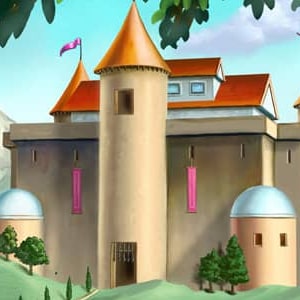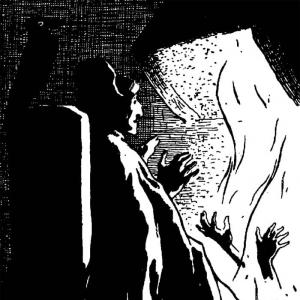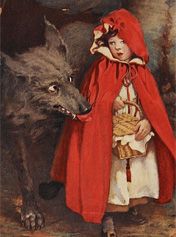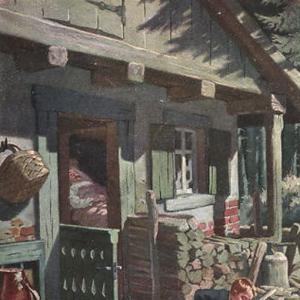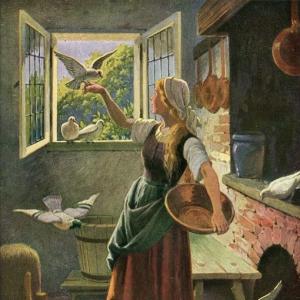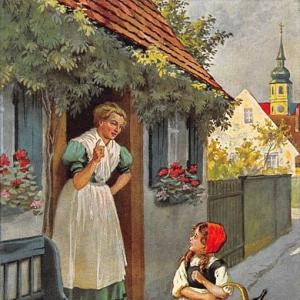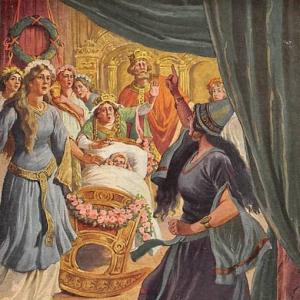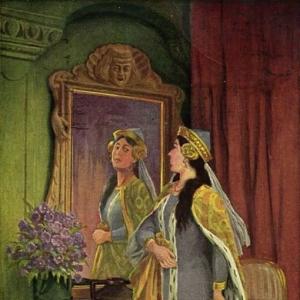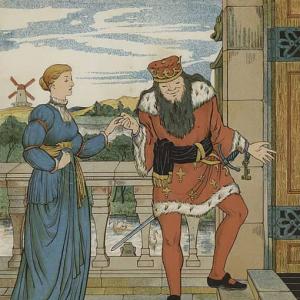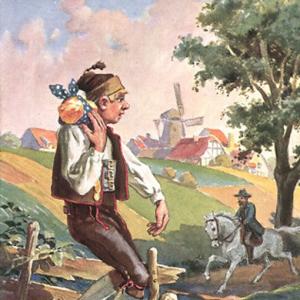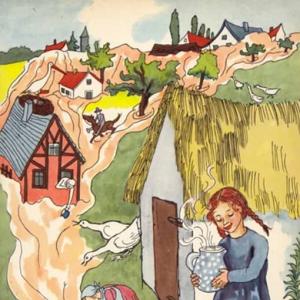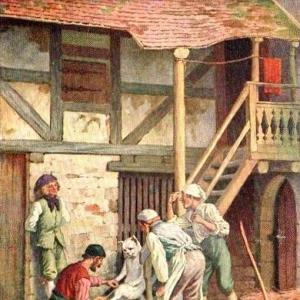Reading time: 8 min
Once in summer-time the bear and the wolf were walking in the forest, and the bear heard a bird singing so beautifully that he said, „Brother wolf, what bird is it that sings so well?“ – „That is the King of birds,“ said the wolf, „before whom we must bow down.“ It was, however, in reality the willow-wren (Zaunkönig). „If that’s the case,“ said the bear, „I should very much like to see his royal palace; come, take me thither.“ – „That is not done quite as you seem to think,“ said the wolf; „you must wait until the Queen comes.“ Soon afterwards, the Queen arrived with some food in her beak, and the lord King came too, and they began to feed their young ones. The bear would have liked to go at once, but the wolf held him back by the sleeve, and said, „No, you must wait until the lord and lady Queen have gone away again.“ So they observed the hole in which was the nest, and trotted away. The bear, however, could not rest until he had seen the royal palace, and when a short time had passed, again went to it. The King and Queen had just flown out, so he peeped in and saw five or six young ones lying in it. „Is that the royal palace?“ cried the bear; „it is a wretched palace, and you are not King’s children, you are disreputable children!“ When the young wrens heard that, they were frightfully angry, and screamed, „No, that we are not! Our parents are honest people! Bear, thou wilt have to pay for that!“
The bear and the wolf grew uneasy, and turned back and went into their holes. The young willow-wrens, however, continued to cry and scream, and when their parents again brought food they said, „We will not so much as touch one fly’s leg, no, not if we were dying of hunger, until you have settled whether we are respectable children or not. The bear has been here and has insulted us!“ Then the old King said, „Be easy, he shall be punished,“ and he at once flew with the Queen to the bear’s cave, and called in, „Old Growler, why hast thou insulted my children? Thou shalt suffer for it we will punish thee by a bloody war.“ Thus war was announced to the Bear, and all four-footed animals were summoned to take part in it, oxen, asses, cows, deer, and every other animal the earth contained. And the willow-wren summoned everything which flew in the air, not only birds, large and small, but midges, and hornets, bees and flies had to come.
When the time came for the war to begin, the willow-wren sent out spies to discover who was the enemy’s commander-in-chief. The gnat, who was the most crafty, flew into the forest where the enemy was assembled, and hid herself beneath a leaf of the tree where the watchword was to be given. There stood the bear, and he called the fox before him and said, „Fox, thou art the most cunning of all animals, thou shalt be general and lead us.“ – „Good,“ said the fox, „but what signal shall we agree upon?“ No one knew that, so the fox said, „I have a fine long bushy tail, which almost looks like a plume of red feathers. When I lift my tail up quite high, all is going well, and you must charge; but if I let it hang down, run away as fast as you can.“ When the gnat had heard that, she flew away again, and revealed everything, with the greatest minuteness, to the willow-wren. When day broke, and the battle was to begin, all the four-footed animals came running up with such a noise that the earth trembled. The willow-wren also came flying through the air with his army with such a humming, and whirring, and swarming that every one was uneasy and afraid, and on both sides they advanced against each other. But the willow-wren sent down the hornet, with orders to get beneath the fox’s tail, and sting with all his might. When the fox felt the first sting, he started so that he drew up one leg, with the pain, but he bore it, and still kept his tail high in the air; at the second sting, he was forced to put it down for a moment; at the third, he could hold out no longer, and screamed out and put his tail between his legs. When the animals saw that, they thought all was lost, and began to fly, each into his hole and the birds had won the battle.
Then the King and Queen flew home to their children and cried, „Children, rejoice, eat and drink to your heart’s content, we have won the battle!“ But the young wrens said, „We will not eat yet, the bear must come to the nest, and beg for pardon and say that we are honorable children, before we will do that.“ Then the willow-wren flew to the bear’s hole and cried, „Growler, thou art to come to the nest to my children, and beg their pardon, or else every rib of thy body shall be broken.“ So the bear crept thither in the greatest fear, and begged their pardon. And now at last the young wrens were satisfied, and sat down together and ate and drank, and made merry till quite late into the night.
 Learn languages. Double-tap on a word.Learn languages in context with Childstories.org and Deepl.com.
Learn languages. Double-tap on a word.Learn languages in context with Childstories.org and Deepl.com.Backgrounds
Interpretations
Adaptions
Summary
Linguistics
„The Willow-Wren and the Bear“ is a German fairy tale collected by the Brothers Grimm, Jacob and Wilhelm, in their anthology „Grimms‘ Fairy Tales“ (also known as „Children’s and Household Tales“ or „Kinder- und Hausmärchen“). The Brothers Grimm were German scholars, linguists, and authors who lived during the late 18th and early 19th centuries. Their collection of fairy tales has become one of the most famous and influential works of folklore in the Western world.
The Grimm brothers collected and published hundreds of stories, many of which were based on traditional folk tales that had been passed down orally for generations. They aimed to preserve these stories in written form, often editing and adapting them to align with the literary tastes and cultural values of their time. In addition to fairy tales, the Grimm brothers were also interested in preserving German language and culture, and they contributed to the development of the modern study of folklore.
„The Willow-Wren and the Bear“ is one of the lesser-known stories from the Grimm brothers‘ collection, but it shares many common themes and motifs with other well-known fairy tales, such as the triumph of the underdog, the importance of teamwork and unity, and the consequences of arrogance and pride. Like many of the other stories collected by the Brothers Grimm, this tale has been passed down through generations and continues to be enjoyed by readers worldwide.
„The Willow-Wren and the Bear“ offers several interpretations and themes that can be drawn from the story:
Unity and teamwork: The story highlights the power of unity and teamwork, as the wrens and their diverse group of flying allies work together to defeat the larger and seemingly more powerful bear and his army. The victory demonstrates that even small creatures can achieve great things when they band together.
The underdog’s triumph: The tale portrays the willow-wren and its family as underdogs, underestimated by the bear and the four-footed animals. The victory of the birds symbolizes the triumph of the underdog, a common theme in many fairy tales and folklore, reminding readers that size and strength are not the only factors determining success.
The consequences of pride and arrogance: The bear’s arrogance and mockery of the wren family’s humble nest set the events of the story in motion. His refusal to apologize ultimately leads to war and his own humiliation. This theme teaches readers about the importance of humility and the consequences of pride.
Cunning and intelligence over brute strength: The wrens‘ victory is achieved through cunning and intelligence rather than brute strength. The gnat’s spying, the hornet’s targeted attack, and the willow-wren’s strategy all play significant roles in overcoming the bear and his army, emphasizing the value of wit and wisdom in difficult situations.
The importance of honor and respect: The young wrens demand an apology from the bear for his insult, showing that they value honor and respect. The story emphasizes the significance of recognizing and respecting the dignity and worth of others, regardless of their size or status.
„The Willow-Wren and the Bear“ has been adapted in various forms over the years, including:
Children’s Books: The tale has been adapted into many children’s books, with colorful illustrations and simplified language to make it accessible to young readers.
Animated Films: Several animated adaptations of the tale have been produced, including a 1951 Soviet film called „The Bear and the Little Bird,“ and a 1968 British cartoon called „The Willow Wren and the Bear.“
Stage Productions: The story has been adapted for the stage, including a puppet play version performed at the Salzburg Marionette Theater in Austria.
Literary Adaptations: The tale has also been adapted into various literary works, such as a retelling by Anne Sexton in her book „Transformations,“ and a chapter in Roald Dahl’s book „Revolting Rhymes.“
Musical Adaptations: The tale has been adapted into musicals, including „The Willow Wren and the Bear“ by Scottish composer Alan Fleming-Baird.
Video Games: The tale has been adapted into video games, including a puzzle game called „The Willow-Wren and the Bear“ released for iOS and Android devices in 2018.
Overall, „The Willow-Wren and the Bear“ has proven to be a popular and versatile tale that has inspired many creative adaptations across different media.
„The Willow-Wren and the Bear“ by the Brothers Grimm is a fairy tale about a bear who, upon hearing a bird’s beautiful song, discovers the willow-wren and his family. The bear mocks the wren family’s simple nest, prompting the young wrens to demand retribution.
When the bear refuses to apologize, the wrens and their animal friends wage war against the bear and his army of four-footed animals. The crafty gnat, sent as a spy by the willow-wren, discovers the fox’s battle signal plan and informs the wren. On the day of the battle, the wrens send the hornet to sting the fox’s tail, causing the fox to lower it in pain, signaling retreat. The four-footed animals flee in defeat, and the birds are victorious.
After their victory, the young wrens demand the bear to come and apologize before they celebrate. The willow-wren forces the bear to beg for forgiveness, and the satisfied wrens eat, drink, and celebrate their victory.
The fairy tale „The Willow-Wren and the Bear“ by the Brothers Grimm offers a rich opportunity for linguistic analysis, highlighting several interesting elements of narrative style, language use, and thematic content typical of Grimm’s fairy tales.
Here are some key aspects to consider
Characterization through Dialogue: The dialogue between characters is used primarily to establish personality traits and social dynamics. For instance, the bear’s curiosity and impatience are evident in his insistence on seeing the so-called „royal palace“ of the willow-wren, while the wolf’s knowledge and caution are conveyed in his advice to wait for the Queen’s arrival. Dialogue helps define the characters‘ relationships and move the plot forward.
Use of Animal Characters: In typical fable fashion, animals are anthropomorphized to reflect human characteristics and social hierarchies. The bear and wolf represent physical strength and cunning, respectively, while the willow-wren embodies cleverness and determination. This use of animals allows the tale to explore complex themes such as respect, insult, and retribution in a simplified and engaging manner.
Narrative Structure: The story follows a classic fairy tale structure, beginning with a disturbance (the bear’s insult), leading to a conflict (the war between four-footed animals and birds), and concluding with a resolution (the bear’s apology). This structure is efficient, providing a moral lesson about the consequences of underestimating others and the importance of respect.
Repetition and Formulaic Language: Repetition is a key linguistic feature in Grimm’s tales, used for emphasis and to aid in oral storytelling. Phrases like „thou shalt suffer for it,“ „bloody war,“ and „beg for pardon“ reinforce the tale’s moral and dramatic elements. The formulaic structure of such expressions ensures that listeners, particularly children, can predict and remember the narrative.
Moral and Social Commentary: The tale subtly critiques social hierarchies and prejudice. The bear’s assumption that the willow-wren’s nest cannot be a royal palace reflects a superficial judgment based on appearances. The victorious outcome for the willow-wrens suggests a democratic or egalitarian theme, challenging social norms by showing that even the smallest creatures can triumph through cleverness and unity.
Symbolism: The willow-wren symbolizes the underestimated and marginalized who, when provoked, can mobilize effectively against larger forces. The bear, a symbol of brute force, is ultimately humbled by the intelligence and solidarity of the smaller, seemingly weaker animals.
Overall, „The Willow-Wren and the Bear“ is a rich text for linguistic and thematic analysis, exemplifying the Brothers Grimm’s talent for blending moral lessons with engaging storytelling. The tale utilizes simple yet effective language to convey timeless themes of respect, intelligence, and the power dynamics between the mighty and the meek.
Information for scientific analysis
Fairy tale statistics | Value |
|---|---|
| Number | KHM 102 |
| Aarne-Thompson-Uther-Index | ATU Typ 222 |
| Translations | DE, EN, EL, DA, ES, FR, PT, FI, HU, IT, JA, NL, PL, RU, TR, VI, ZH |
| Readability Index by Björnsson | 32.5 |
| Flesch-Reading-Ease Index | 78.2 |
| Flesch–Kincaid Grade-Level | 8.2 |
| Gunning Fog Index | 11 |
| Coleman–Liau Index | 7.6 |
| SMOG Index | 8.8 |
| Automated Readability Index | 9.2 |
| Character Count | 4.834 |
| Letter Count | 3.683 |
| Sentence Count | 39 |
| Word Count | 926 |
| Average Words per Sentence | 23,74 |
| Words with more than 6 letters | 81 |
| Percentage of long words | 8.7% |
| Number of Syllables | 1.144 |
| Average Syllables per Word | 1,24 |
| Words with three Syllables | 36 |
| Percentage Words with three Syllables | 3.9% |

 Facebook
Facebook  Whatsapp
Whatsapp  Messenger
Messenger  Telegram
Telegram Reddit
Reddit